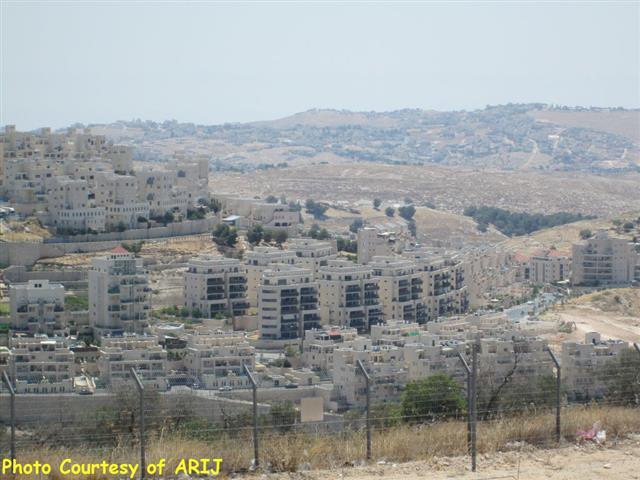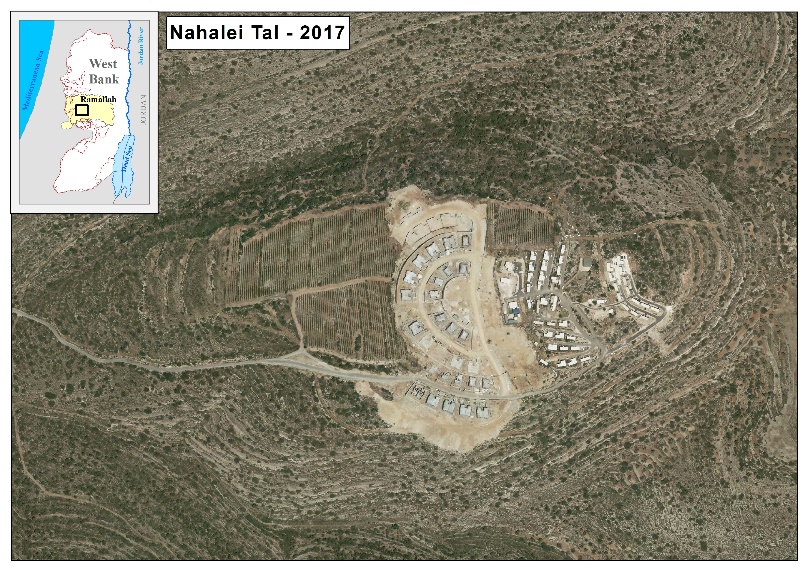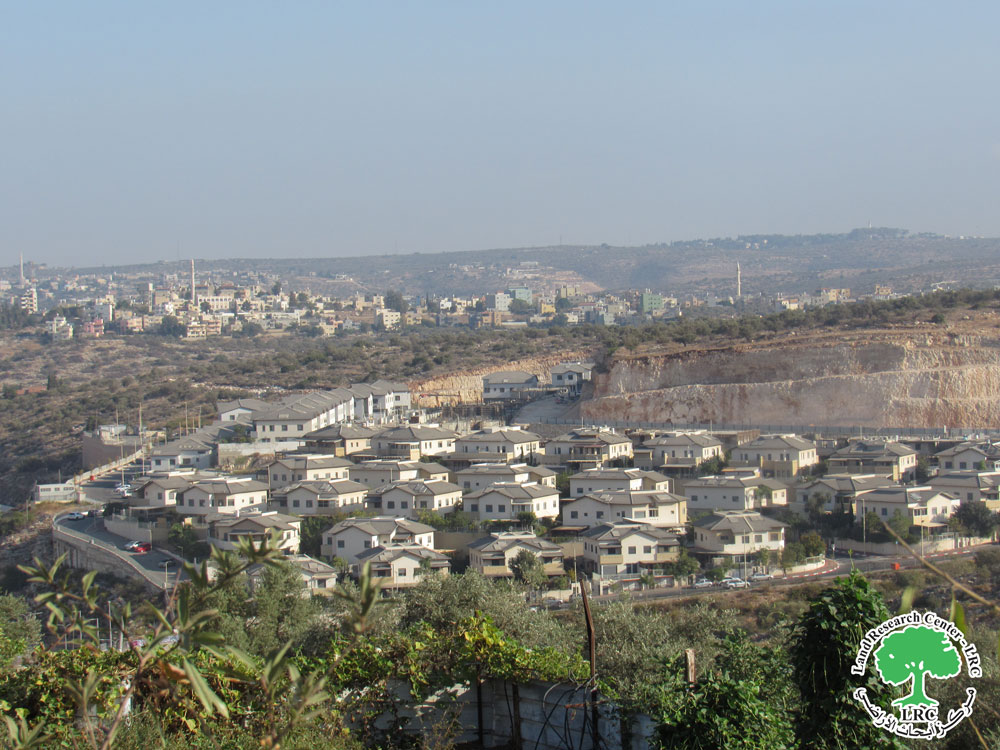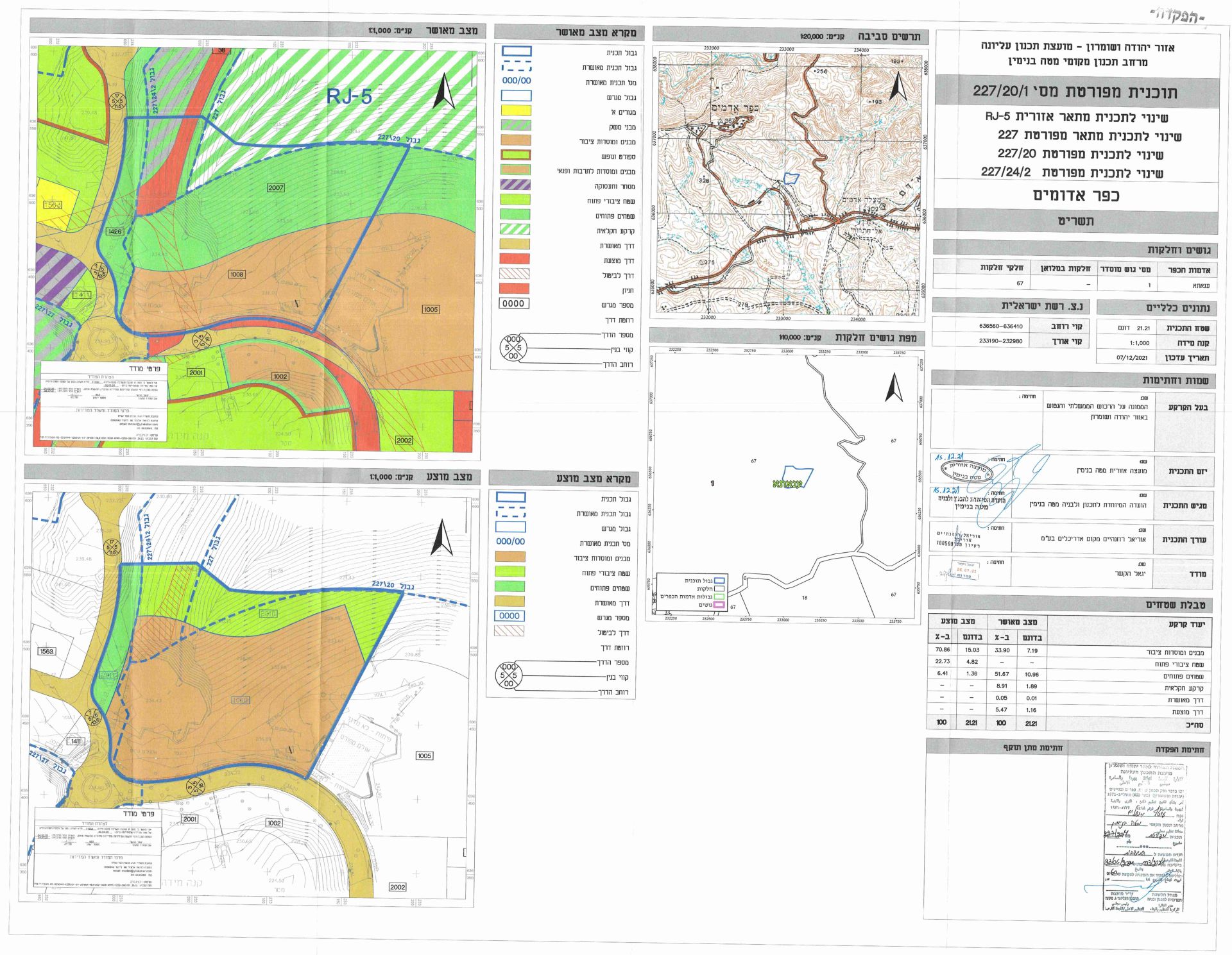On the 24th of May 2014, the Applied Research Institute field team conducted a field visit to the area near Homa settlement north of Beit Sahour city and noticed intensive settlement construction is being carried out at the settlement’s northwestern and southeastern sides, exemplified in the addition of new settlement units on lands of Bethlehem and Beit Sahour cities. The units are being added on top of the Green mountain located next to the existing settlement built-up area. Note that on September 13, 2004, the Israeli Mayor of Jerusalem, Uri Lupolianski, unveiled a master plan "Jerusalem 2000" for Jerusalem city to serve as “a mandatory map for land use”[1] until the year 2020. The plan also includes occupied East Jerusalem. Accordingly, the master Plan indicated the presence of two new settlements in the vicinity of Har Homa settlement in Bethlehem Governorate, one to its southeast and another to its northwest.
Photo 1: One side of Har Homa settlement in 2011
Photo 2: the same side of Har Homa settlement witnessed expansion in 2014
On the 7th of August 2011, the Israeli regional committee for building and planning and in cooperation with the Israeli ministry of Housing and construction and the Israeli Land Administration, approved plan No. 13010 to build 983 new settlement units on the mountain neighboring the current built-up area of Har Homa settlement. The plan was given the name “Har Homa C”. However, the implementation of the plan was halted due the current political situation and the attempts of the US administration and the European community to encourage the Israelis and the Palestinians to revive peace talks and freeze settlement construction meanwhile. See Photo 3 & Photo 4
Photo 3: The mountain next to Har Homa current built-up area in 2011
Photo 4: The same mountain in 2014 and witnessed expansion in 2014
The plan No. 13010 was first promoted on the 8th of November 2010, following the expiration of the 10-months settlement freeze which Netanyahu declared about, on November 25, 2009, as a good gesture from his side to resume negotiations with the Palestinians. See Map 1
Map 1: The future Israeli settlement plans in Har Homa
However, the decision of the Israeli Prime Minister, Benjamin Netanyahu, to freeze settlement activity in the occupied Palestinian territory that time, while excluding occupied East Jerusalem, was a provocative attempt to throw the ball in the Palestinian court, taking advantage of the U.S. weak position with regard to the settlements issue, which has failed to enforce a complete cessation of Israeli settlement activity in the occupied Palestinian territory and Jerusalem, including natural growth.
It’s no doubt that Netanyahu's decision was a strategic move to buy time and impede any more serious efforts to revive the final status negotiations between the Palestinians and Israelis to reach a two-state solution; at the same time, to complete the construction of the segregation wall in the occupied territory and to impose a fait accompli on the Palestinians; and this is exactly what has happened, Israel continued to build settlements despite the announcement of the settlement freeze and completed constructing sections of the Segregation wall in several Palestinian areas in the occupied West Bank. See Photo 5 & Photo 6
Photo 5: Har Homa settlement in 2012
Photo 6: intensive construction is being carried out at the same location in 2014
More Photos
Photo 7: Har Homa settlement in 2012
Photo 8: The same location in Har Homa settlement wintnessed construction in 2014
To conclude
Israel’s continuous settlement activity in the occupied West Bank, including settlements in East Jerusalem comes in violation of international humanitarian law and the rights of the Palestinian people and in violation of the laws and international norms. The following are the most important which prohibit Israeli settlement activity in the occupied Palestinian territory:-
UN Resolutions
UN Security Council Resolution 242 of 1967: calls for
- the Withdrawal of Israel armed forces from territories occupied in the recent conflict;
- Termination of all claims or states of belligerency and respect for and acknowledgment of the sovereignty, territorial integrity and political independence of every State in the area and their right to live in peace within secure and recognized boundaries free from threats or acts of force." [4]
UN Security Council Resolution 449 of 1979: the Security Council determined:
- "that the policy and practices of Israel in establishing settlements in the Palestinian and other Arab territories occupied since 1967 have no legal validity and constitute a serious obstruction to achieving a comprehensive, just and lasting peace in the Middle East"
UN Security Council Resolution 452 of 1979: states that
- "the policy of Israel in establishing settlements in the occupied Arab territories has no legal validity and constitutes a violation of the Fourth Geneva Convention relative to the Protection of Civilian Persons in Time of War of 12 August 1949" and "calls upon the Government and people of Israel to cease, on an urgent basis, the establishment, construction and planning of settlements in the Arab territories occupied since 1967, including Jerusalem."
UN Security Council Resolution 465 of 1980:
- It expressed concern at Israeli settlement policy in the Arab territories and recalled resolutions 237 (1967), 252 (1968), 267 (1969), 271(1969) and 298 (1971). It further called upon the State and people of Israel to dismantle such settlements. The resolution calls on all states ‘not to provide Israel with any assistance to be used specifically in connection with settlements in the occupied territories’.
Convention (IV) respecting the Laws and Customs of War on Land and its annex: Regulations concerning the Laws and Customs of War on Land. The Hague, 18 October 1907.
Article 46. Private property cannot be confiscated.
Article 55: The occupying State shall be regarded only as administrator and usufructuary of public buildings, real estate, forests, and agricultural estates belonging to the hostile State, and situated in the occupied country. It must safeguard the capital of these properties, and administer them in accordance with the rules of usufruct.
- Art. 49. Individual or mass forcible transfers, as well as deportations of protected persons from occupied territory to the territory of the Occupying Power or to that of any other country, occupied or not, are prohibited, regardless of their motive.
- Art. 53. Any destruction by the Occupying Power of real or personal property belonging individually or collectively to private persons, or to the State, or to other public authorities, or to social or cooperative organizations, is prohibited, except where such destruction is rendered absolutely necessary by military operations.
- Art. 147. Grave breaches to which the preceding Article relates shall be those involving any of the following acts, if committed against persons or
property protected by the present Convention: wilful killing, torture or inhuman treatment, including biological experiments, wilfully causing great suffering or serious injury to body or health, unlawful deportation or transfer or unlawful confinement of a protected person, compelling a protected person to serve in the forces of a hostile Power, or wilfully depriving a protected person of the rights of fair and regular trial prescribed in the present Convention, taking of hostages and extensive destruction and appropriation of property, not justified by military necessity and carried out unlawfully and wantonly.
[1] Coalition for Jerusalem: Master Plan 2000 – English Translation
http://coalitionforjerusalem1.blogspot.com/2007/05/master-plan-2000-english-translation.html
Prepared by:
The Applied Research Institute – Jerusalem























